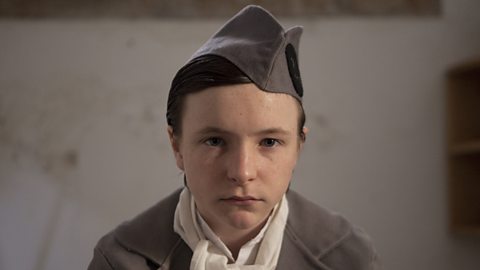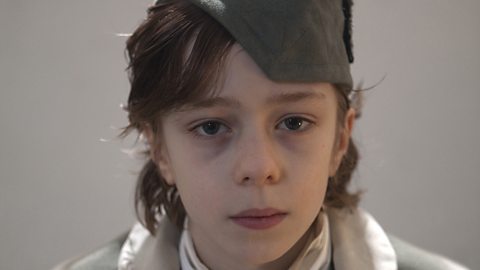Video summary
This short film explores Victorian punishments through the eyes of John, a young offender who was sent to prison for six months in January 1876.
John, who was 14, was accused of forging letters from his employer to allow him to get clothes on credit from local shops. But John insisted that he couldn't possibly be guilty as he cannot write.
Picking oakham, being put to 'the crank', being whipped and even being transported to Australia were all punishments that young criminals would have been subjected to in the 19th Century.
Note that this film includes references to corporal punishment, including a brief dramatisation, which may be upsetting for some KS2 and KS3 pupils. Teacher viewing is recommended prior to showing the film in class.
Teacher Notes
Questions to consider whilst watching the film
Depending on the focus of your lesson, you may wish to ask the following questions after the video or the pause the short film at certain points to check for understanding.
- What was ÔÇśpicking oakumÔÇÖ? Why did it hurt? What was the purpose of doing this?
- What was the reason for ÔÇśthe silent systemÔÇÖ?
- Were there any punishments that had no purpose or reason? If so, why might they be used?
- What punishments were given to children?
- The reason for punishing children at this time was ÔÇśspare the rod and spoil the child.ÔÇÖ What do you think this means?
- _What do we learn from the video about transportation?
- _What do you think would preferable: prison or transportation?
Learning activities to explore after the video
History is a subject which can lend itself to a wide range of cross-curricular links. As a teacher, you will have a greater awareness of how this topic may act as stimulus for learning in other subjects. However, the suggestions below relate solely to ways of developing the childrenÔÇÖs historical knowledge and understanding.ÔÇâKey Question: Do you agree with the view that all Victorian punishments were pointless, painful and cruel?
Develop perspective and judgementThe National Curriculum for England explicit states that history teaching ÔÇśshould equip pupils to ask perceptive questions, think critically, weigh evidence, sift arguments, and develop perspective and judgement.ÔÇÖ These are all skills to be developed in the curricula for all nations of the United Kingdom and this topic lends itself to developing this.
One approach is to start with a provocative statement and then to ask pupils to decide the extent to which they agree or disagree with it. However, to ensure their judgements are historically valid, it is critical they have sufficient knowledge on any given topic. The class could be divided into groups to investigate in more depth one of the punishments or within small groups, individuals could look at different punishments. As an overview for the whole class, there is good background information about Victorian punishments in this Bitesize guide. After that, the class could complete their investigation before coming together to share their findings and make a judgement.
The pupils could focus on each of the punishments mentioned in the video: picking oakham, being put to 'the crank', being whipped or transported to Australia. The video also refers to the silent system and this is explored in more detail in this Bitesize guide. Although it is aimed at older students, the text can be understood by this age group. The pupils could identify the reasons for, and the criticisms of, their chosen punishment.
Having shared their findings and now that the class has knowledge of all the punishments, you can return to the key question and the pupils could be asked to make a judgement; for example, each punishment could be assessed as to whether it was pointless, painful and cruel. It is important to have some agreed criteria for evaluating this; for example, it would be important to give consideration to both physical and mental pain and cruelty. The children could then be asked to consider why none of these punishments are used in the prison system today?
Key Question: What does the historical evidence tells us about Victorian punishments?
Historical EnquiryAs with previous investigations in this series, there are opportunities to study original sources about individual Victorian criminals. has a range of sources, documentaries and visuals about Victorian prisons. This is an external link. The 91╚╚▒Č is not responsible for the content.Alongside the sources, there are a series of structured questions to help the pupils interrogate the evidence.
Key Question: How cruel were the Victorians?
Historical InterpretationThe topic of punishments is covered in another 91╚╚▒Č Teach video: Dodger's guide to crime and punishment. The teacherÔÇÖs notes for this video suggest developing the pupilsÔÇÖ understanding of historical interpretation. The first enquiry would only make sense in relation to the Dodger video. However, the second enquiry on the website would be relevant to this study of John Smith. It asks the pupils to consider whether the Victorians were cruel and so in addition to looking at the cruel prison punishments, there is also a study of those, like Elizabeth Fry, with different views about prison life. The class should explore that there are different opinions for any historical topic and that an historian must look at both sides of the argument before reaching a balanced conclusion.
Learning aims or objectives
England
From the History National CurriculumPupils should:
- develop perspective and judgement.
- discern how and why contrasting arguments and interpretations of the past have been constructed.
- understand the methods of historical enquiry, including how evidence is used rigorously to make historical claims.
Northern Ireland
From the statutory requirements for Key Stage 2 - The World Around UsPupils should be enabled to explore:
- Change over time in places.To provide a balance of experiences in history pupils could study:
- Some of the characteristics of past societies and distinctive features of life in the past.Teaching should provide opportunities for children as they move through Key Stages 1 and 2 to progress:
- from identifying similarities and differences to investigating similarities and differences, patterns and change.
Scotland
From the Experiences and Outcomes for planning learning, teaching and assessment ofSecond Level Social Studies:
- I can use primary and secondary sources selectively to research events in the past.
- I can compare and contrast a society in the past with my own and contribute to a discussion of the similarities and differences.
- I can interpret historical evidence from a range of periodsÔÇŽ
Wales
From the new Humanities Area of Learning and ExperienceSchool curriculum design for history should:
- develop historical ÔÇŽ source-based skills.
- develop historical interpretation, understanding and source-based skills.
- develop rich content across the time periods, through which learners can develop an understanding of chronology through exploring ÔÇŽ interpretations.
Principles of progressionDescriptions of learning for Progression Step 2
Enquiry, exploration and investigation inspire curiosity about the world, its past, present and future:
- I have been curious and made suggestions for possible enquiries and have asked and responded to a range of questions during an enquiry.
- I have experienced a range of stimuli, and had opportunities to participate in enquiries, both collaboratively and with growing independence.
Events and human experiences are complex, and are perceived, interpreted and represented in different ways.
- I can recognise and explain that my opinions and the opinions of others have value.
- I can recognise that opinions may change over time.
How the Victorians introduced photograph police records. video
The story of young offender James Dunn Barr is used to explain how the invention of photography changed the way criminals, young and old, could be identified.

Life at a Victorian reformatory school. video
Jane Angus, aged 12, tells us how she was caught stealing and sent to a residential school where young criminals were taught a trade to stop them re-offending.

Life at a Victorian industrial school. video
13-year-old James Fleming from Perth explains how he came to be sent to an industrial school.
